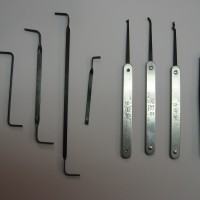LOCKSMITH TOOLS OF THE TRADE “LOCK PICKS, FLIPPERS AND MONKEYS”
TENSION WRENCH OR TURNING TOOL
To pick a lock usually requires two (2) tools, a lock pick and a tension wrench” or “turning tool.”
I won’t go into semantics on the proper name for the tension wrench or turning tool, etc.. For the purpose of this book I will call it a tension wrench. Also, the majority of suppliers and manufacturers call it a tension wrench in their catalogs.
Selecting the Tension Wrench is just as important as selecting the lock pick. I consider the tension wrench the most important lock picking tool to open a lock. Without proper tension the lock is difficult to pick open.
Several different types of tension wrenches are available. They range from light to heavy spring steel, speciality tension wrenches (Peterson, Falle, etc.) and home made tension wrenches made from spring steel and allen keys.
You have to experiment with different tension wrenches to find what works best for you and also for the different locks you will pick open. To start picking a standard Weiser o/Kwikset or Schlage lock I prefer a rigid tension wrench and place it in the top of the keyway with a very light tension. Beginners should use a light tension wrench to start. For practice picking apply tension clockwise or counter clockwise. I try picking the lock to the unlocked position. However, the third most important tool in my lock picking kit is the “Flipper” or ‘Plug Spinner” (more on using a “Flipper” or “Plug Spinner” if you pick the lock the wrong way in an upcoming Blog). If this fails to pick open the lock I change to a medium tension wrench and again light tension.
Different locks require different tension wrenches and picks. Also, their is no right or wrong way if you are comfortable and confident and the end result is a picked lock.
However, you should never bend or break a lock pick. Be gentle, have “nice hands” (ask the ladies about “nice hands”). Sometimes you can be rough but the most successful lock pickers use light tension and have “nice hands.”
Note: Do not use too much turning tension. The most common cause of failure to pick a non-malfunctioning lock is to much tension that will bind the pins so they are unable to move.
My next Blog will be on the various lock picks.
Thanks
Terry Whin-Yates


